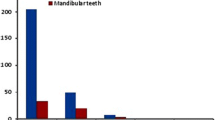Abstract
Traumatic dental injuries (TDI) or tooth trauma have a global prevalence of 10–15%. These are often the cause of first visit to emergency room. Prognosis of teeth after injury is dependent on type of TDI, emergency treatment and time elapsed till definitive care. The low level of awareness among general public and medical practitioners often leads to delay in seeking treatment which often leads to pain, severe symptoms and poor prognosis. Pediatricians can play a significant role in identification of TDI, health advise, emergency care and referral to dentists. This paper highlights the important features to be noted in children with history of TDI and the key steps which needs to be taken in these situations.




Similar content being viewed by others
References
Petti S, Glendor U, Andersson L. World traumatic dental injury prevalence and incidence, a meta-analysis - one billion living people have had traumatic dental injuries. Dent Traumatol. 2018;34:71–86. https://doi.org/10.1111/edt.12389.
Andreasen JO, Andreasen FM, Andersson L. Textbook and Color Atlas of Traumatic Injuries to the Teeth. 4th ed. Oxford: Blackwell Munksgaard; 2007.
Andreasen JO, Ravn JJ. Epidemiology of traumatic dental injuries to primary and permanent teeth in a Danish population sample. Int J Oral Surg. 1972;1:235–9.
Shulman JD, Peterson J. The association between incisor trauma and occlusal characteristics in individuals 8–50 years of age. Dent Traumatol. 2004;20:67–74.
Nguyen QV, Bezemer PD, Habets L, Prahl-Andersen B. A systematic review of the relationship between overjet size and traumatic dental injuries. Eur J Orthod. 1999;21:503–15.
Sabuncuoglu O, Taser H, Berkem M. Relationship between traumatic dental injuries and attention-deficit/hyperactivity disorder in children and adolescents: proposal of an explanatory model. Dent Traumatol. 2005;21:249–53.
Kargul B, Welbury R. An audit of the time to initial treatment in avulsion injuries. Dent Traumatol. 2009;25:123–5.
Diangelis AJ, Andreasen JO, Ebeleseder KA, et al; International Association of Dental Traumatology. International Association of Dental Traumatology guidelines for the management of traumatic dental injuries: 1. Fractures and luxations of permanent teeth. Dent Traumatol. 2012;28:2–12.
Andersson L, Andreasen JO, Day P, et al; International Association of Dental Traumatology. International Association of Dental Traumatology guidelines for the management of traumatic dental injuries: 2. Avulsion of permanent teeth. Dent Traumatol. 2012;28:88–96.
Malmgren B, Andreasen JO, Flores MT, et al; International Association of Dental Traumatology. International Association of Dental Traumatology guidelines for the management of traumatic dental injuries: 3. Injuries in the primary dentition. Dent Traumatol. 2012;28:174–82.
El-Kalla IH, Shalan HM, Bakr RA. Impact of dental trauma on quality of life among 11-14 years schoolchildren. Contemp Clin Dent. 2017;8:538–44.
Padmanabhan MY, Pandey RK, Tewari N, Aparna R. Evaluating intrusive injuries in primary dentition from computed tomographic scans: a preliminary report. Indian J Dent Res. 2014;25:311–5.
Tewari N, Pandey RK. Root hypoplasia: an unusual sequela to primary tooth trauma. Dent Traumatol. 2010;26:115–7.
Tewari N, Pandey RK. Multiple abnormalities in permanent maxillary incisors following trauma to the primary dentition. J Indian Soc Pedod Prev Dent. 2011;29:161–4.
Trivedy C, Kodate N, Ross A, et al. The attitudes and awareness of emergency department (ED) physicians towards the management of common dentofacial emergencies. Dent Traumatol. 2012;28:121–6.
World Health Organization. Health promoting schools: a healthy setting for living, learning and working. Geneva: WHO; 1998.
Nowjack-Raymer RE, Gift HC. Use of mouthguards and headgear in organized sports by school-aged children. Public Health Rep. 1996;111:82–6.
Author information
Authors and Affiliations
Contributions
NT: Conceptualization of the study, provided the data, wrote the manuscript & approved the final version of the manuscript; KB: Conceptualization of the study, wrote & approved the final version of the manuscript; VPM: Concept, wrote the manuscript, provided critical appraisal & approved the final version of the manuscript. VPM is the guarantor for this manuscript.
Corresponding author
Ethics declarations
Conflict of Interest
None.
Additional information
Publisher’s Note
Springer Nature remains neutral with regard to jurisdictional claims in published maps and institutional affiliations.
Rights and permissions
About this article
Cite this article
Tewari, N., Bansal, K. & Mathur, V.P. Dental Trauma in Children: A Quick Overview on Management. Indian J Pediatr 86, 1043–1047 (2019). https://doi.org/10.1007/s12098-019-02984-7
Received:
Accepted:
Published:
Issue Date:
DOI: https://doi.org/10.1007/s12098-019-02984-7




